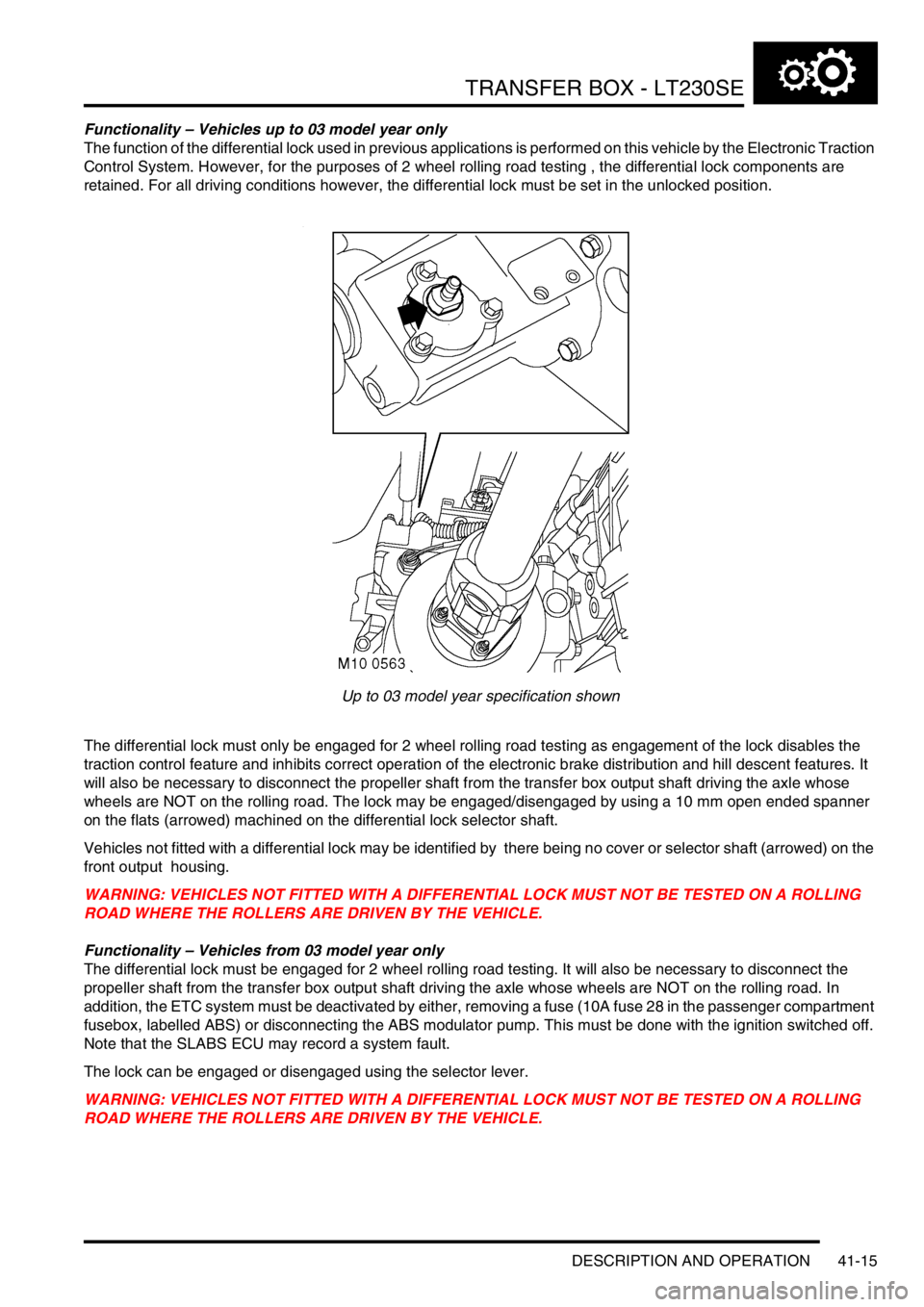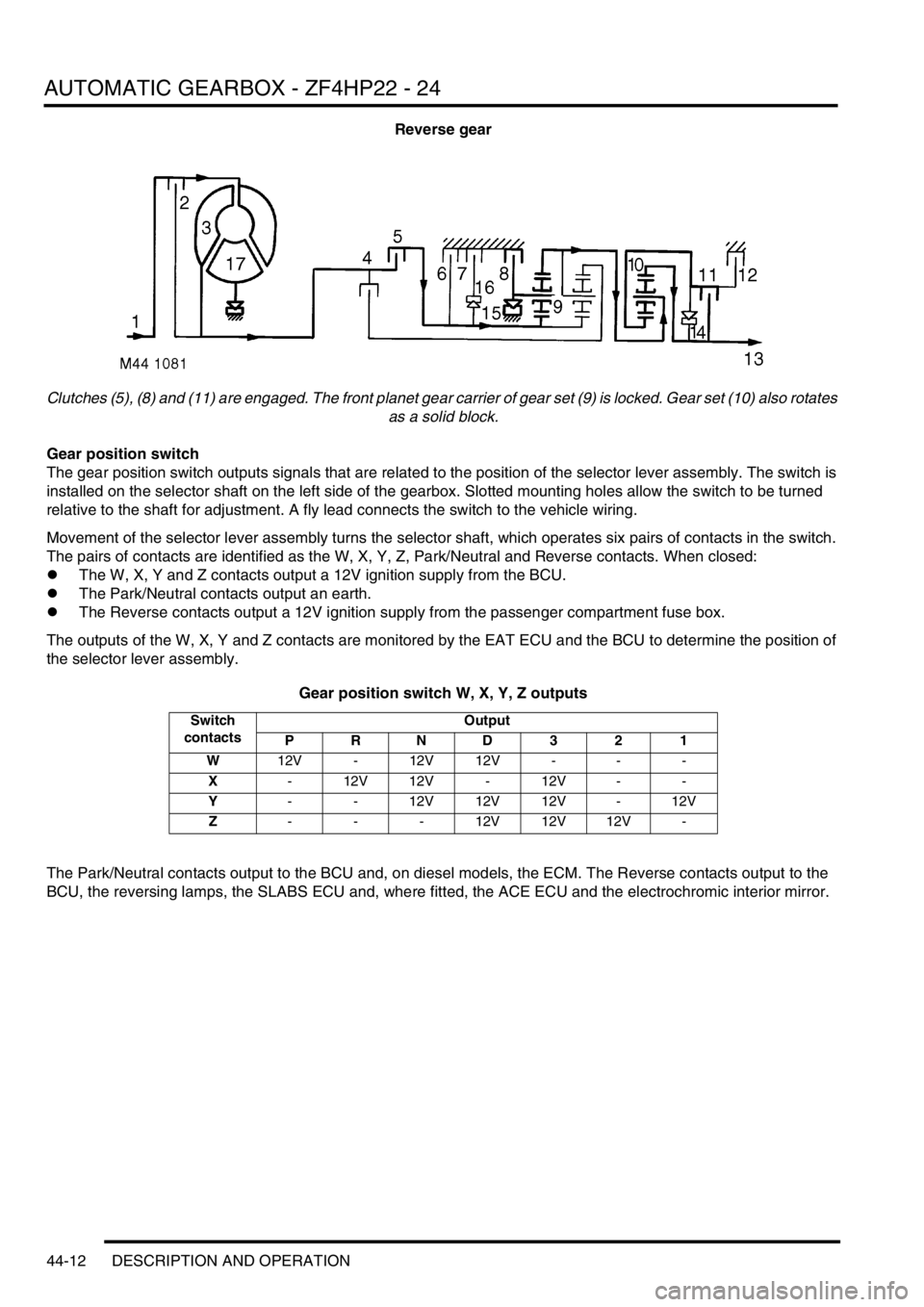ignition LAND ROVER DISCOVERY 1999 Repair Manual
[x] Cancel search | Manufacturer: LAND ROVER, Model Year: 1999, Model line: DISCOVERY, Model: LAND ROVER DISCOVERY 1999Pages: 1529, PDF Size: 34.8 MB
Page 452 of 1529

MANIFOLDS AND EXHAUST SYSTEMS - V8
REPAIRS 30-2-17
20.Remove 6 bolts securing upper inlet manifold
and remove upper inlet manifold.
21.Collect upper inlet manifold gasket. Refit
1.Clean upper and lower inlet manifold mating
faces, dowels and dowel holes.
2.Using a new gasket, position upper inlet
manifold. Fit bolts and, working in a diagonal
sequence, tighten to 22 Nm (16 lbf.ft).
3.Connect hose and multiplug to TP sensor.
4.Connect hose and multiplug to IACV. Secure
hose with clip.
5.Secure ht leads to upper inlet manifold.
6.Position ignition coils, fit bolts and tighten to 8
Nm (6 lbf.ft).
7.Ensure clip under ignition coils is located on
fuel pipe.
8.Secure engine harness in bulkhead clips.
9.Fit coolant rail bolt and tighten to 22 Nm (16
lbf.ft).
10.Connect breather hose to inlet plenum.
11.Connect brake servo vacuum pipe to inlet
plenum.
12.Connect EVAP pipe to inlet plenum.
13.Position coolant hoses to throttle body and
secure hose clips.
14.Fit breather hose to throttle body and secure
clip.
15.Connect multiplug to throttle body.
16.Connect throttle and cruise control cables and
secure in throttle body cams.
17.Adjust throttle and cruise control cables.
l
+ ENGINE MANAGEMENT SYSTEM
- V8, ADJUSTMENTS, Cable - cruise
control.
l
+ ENGINE MANAGEMENT SYSTEM
- V8, ADJUSTMENTS, Cable - throttle.
18.Connect air intake hose and tighten clips.
Secure harness to air intake hose.
19.Top-up cooling system
+ MAINTENANCE, PROCEDURES,
Cooling system..
20.Fit bonnet.
+ EXTERIOR FITTINGS, REPAIRS,
Bonnet.
21.Connect battery earth lead.
22.Fit battery cover and secure with fixings.
Page 538 of 1529

TRANSFER BOX - LT230SE
DESCRIPTION AND OPERATION 41-13
Description
General
The LT 230SE transfer box is mounted at the rear of the gearbox and transmits drive via high or low reduction ratios
to the front and rear axles via the propeller shafts. The high/low ratios are 1.211:1 and 3.32:1 respectively.
Transfer boxes fitted to this model have the prefixes 41D and 42D to the unit serial number. Prefix 41D denotes that
the unit is not fitted with interlock whilst 42D denotes that interlock is fitted.
Vehicles up to 03 model year – Whilst similar to LT230Q transfer boxes fitted to other models, the LT230SE transfer
box has certain engineering modifications incorporated which are as follows:
lUprated torque capacity
lModified front and rear output and cross shaft housings
lIntermediate gear bearing pre-load now controlled by a selective, non-collapsible spacer
lSpeedometer drive and driven gears not fitted for this application
lModified high/low sleeve
lModified front output flange and mud shield
lDifferential lock fitted to certain vehicles, but no longer driver operated
lFixed setting of differential lock warning lamp switch on vehicles fitted with differential lock
Vehicles from 03 model year – The LT230SE transfer box is as described above for vehicles up to 03 model year
with the following modifications:
The following items are introduced on vehicles from 03 model year
lRibs added to main casing to reduce operating noise
lRevised machining process for intermediate gears to reduce operating noise
lBearing retaining nut on the differential carrier has patchlock added to the threads
lInterlock solenoid moved from main casing to selector lever assembly
lIntermediate gears modified with machined internal shoulder and bearing circlips deleted
lDriver operated differential lock
lHigh/Low selector shaft fitted with spring assist
lExisting differential lock switch replaced by 2 new switches of improved design with the additional switch installed
adjacent to the existing switch location.
Construction
The transfer box comprises three main assemblies; the main casing, the front output housing and the rear output
housing. Both output housings and all cover plates are sealed to the main casing by sealant; mud and water ingress
being prevented by mud shields located on the output flanges.
Main casing
The main casing carries the mainshaft input gear, the intermediate gears and the differential, together with the high/
low range gears, selector shaft and fork. The front and rear output housings are bolted to either side of the main
casing.
Transmission neutral sensor
A transmission neutral sensor is fitted on automatic gearbox vehicles for North America and Japan. The sensor is
connected to the BCU and is normally in the open position. The sensor provides an earth path for the BCU which then
interprets the signal and activates an audible warning generated by the IDM if neutral is selected on the transfer box
when the ignition is on.
Transfer box interlock solenoid - Automatic gearbox vehicles
An interlock solenoid is fitted for North America and Japan. The solenoid is located on the top of the transfer box main
casing on vehicles up to 03 model year or on the selector lever assembly on vehicles from 03 model year. The
solenoid is connected to the transfer box relay which, in turn, is controlled by the IDM. The purpose of the solenoid is
to prevent neutral being selected on the transfer box when the ignition key is removed, thereby locking the box in
either high or low ratio.
Page 540 of 1529

TRANSFER BOX - LT230SE
DESCRIPTION AND OPERATION 41-15
Functionality – Vehicles up to 03 model year only
The function of the differential lock used in previous applications is performed on this vehicle by the Electronic Traction
Control System. However, for the purposes of 2 wheel rolling road testing , the differential lock components are
retained. For all driving conditions however, the differential lock must be set in the unlocked position.
Up to 03 model year specification shown
The differential lock must only be engaged for 2 wheel rolling road testing as engagement of the lock disables the
traction control feature and inhibits correct operation of the electronic brake distribution and hill descent features. It
will also be necessary to disconnect the propeller shaft from the transfer box output shaft driving the axle whose
wheels are NOT on the rolling road. The lock may be engaged/disengaged by using a 10 mm open ended spanner
on the flats (arrowed) machined on the differential lock selector shaft.
Vehicles not fitted with a differential lock may be identified by there being no cover or selector shaft (arrowed) on the
front output housing.
WARNING: VEHICLES NOT FITTED WITH A DIFFERENTIAL LOCK MUST NOT BE TESTED ON A ROLLING
ROAD WHERE THE ROLLERS ARE DRIVEN BY THE VEHICLE.
Functionality – Vehicles from 03 model year only
The differential lock must be engaged for 2 wheel rolling road testing. It will also be necessary to disconnect the
propeller shaft from the transfer box output shaft driving the axle whose wheels are NOT on the rolling road. In
addition, the ETC system must be deactivated by either, removing a fuse (10A fuse 28 in the passenger compartment
fusebox, labelled ABS) or disconnecting the ABS modulator pump. This must be done with the ignition switched off.
Note that the SLABS ECU may record a system fault.
The lock can be engaged or disengaged using the selector lever.
WARNING: VEHICLES NOT FITTED WITH A DIFFERENTIAL LOCK MUST NOT BE TESTED ON A ROLLING
ROAD WHERE THE ROLLERS ARE DRIVEN BY THE VEHICLE.
Page 541 of 1529

TRANSFER BOX - LT230SE
41-16 DESCRIPTION AND OPERATION
Differential lock warning lamp switch - if fitted - Vehicles up to 03 model year
A differential lock warning lamp switch connected to the SLABS ECU and operated by movement of the selector fork
and shaft is screwed into the top of the output housing. The switch connects to earth when the differential lock is
engaged.
Differential lock warning lamp switches - Vehicles from 03 model year
Vehicles from 03 model year are fitted with two differential lock warning lamp switches.
Both switches are of a new design and are fitted into the top of the front output housing. The switches are connected
to the SLABS ECU and are operated by movement of the selector shaft.
Both switches have an aluminium washer which seals the switch to the casing and also sets the switch position,
removing the requirement for a setting procedure.
Both switches are connected in parallel to earth when the differential lock is engaged. This earth is sensed by the
SLABS ECU which illuminates the differential lock warning lamp in the instrument pack.
Differential lock warning lamp - Vehicles up to 03 model year – if fitted
The differential lock warning lamp is located in the instrument pack and provides a warning to the driver when the
ignition is switched on that the differential lock is engaged. The warning lamp illuminates in a Red colour.
With the lock engaged, the traction control and electronic brake distribution warning lamps will also be illuminated.
Disengagement of the differential lock should be carried out with the ignition switched off. The warning lamps must
be extinguished when the ignition is switched on again.
Differential lock warning lamp – vehicles from 03 model year
The differential lock warning lamp is amber coloured and is located in the instrument pack.
When the lock is engaged, the warning lamp is illuminated and the instrument pack sounder emits three audible
chimes. When the lock is disengaged, the warning lamp is extinguished and the instrument pack sounder emits three
audible chimes.
Rear output housing
The rear output housing carries the output shaft and flange. A cable operated transmission brake is attached to the
housing, the brake drum being attached to the output flange.
The rear output shaft is supported in the housing by a single bearing and is splined into the differential rear sun gear.
Lubrication
Lubrication is by splash, oil filler/level and drain plugs being located in the main casing.
Internal pressures caused by thermal expansion and contraction are avoided by the use of a plastic breather pipe
venting the interior of the box to atmosphere. The pipe is attached to the top of the high/low selector housing by a
banjo bolt and is then routed in a continuously rising path into the engine compartment where the open end is secured
by a clip attached to the engine cylinder block.
Oil temperature warning lamp switch
An oil temperature switch is fitted to V8 engine models up to 03 Model Year. In the event of the transfer box oil
approaching maximum recommended working temperature of 145°C (293°F), the switch will close and a warning
lamp in the instrument pack will be illuminated.
Page 542 of 1529

TRANSFER BOX - LT230SE
DESCRIPTION AND OPERATION 41-17
High/Low range and differential lock selector lever assembly – Vehicles from 03 model year
1Selector lever
2High/Low range cable
3Differential lock cable4Interlock solenoid - North America and Japan
only
On vehicles fitted with a differential lock, the high/low range selector lever as fitted on previous models also
incorporates the differential lock selector on vehicles from 03 model year.
The lever can be moved forwards or backwards to select high, neutral or low range or sideways to select differential
lock engaged or disengaged, on vehicles with differential lock fitted.
The selector lever assembly comprises an aluminium casting with bosses for location of the two cables, the selector
lever mechanism and a housing for the interlock solenoid (if fitted). The upper face of the casting has threaded holes
which allow for the attachment of the casting to the mounting plate which is attached to the transmission tunnel.
A boss at the front provides location for the differential lock cable. The cable is attached to a lever which in turn is
attached to the selector lever. Movement of the selector lever is passed via the lever to the cable which moves the
differential lock selector shaft.
A second boss provides for the location of the high/low range cable. The cable is attached to a plate which moves in
a forward or rearward direction with the selector lever. On North American and Japanese specification models, plate
movement is prevented by an interlock solenoid when the ignition key is not in the ignition.
When fitted, the interlock solenoid is located on the right hand side of the selector lever casting. The solenoid is fitted
into a cast housing in the casting and retained with a circlip. Sealant is applied over the circlip to seal the solenoid in
the housing to prevent the ingress of dirt and moisture. The solenoid performs the same function as on previous
models, preventing the selection of neutral on the transfer box when the ignition key is not in the ignition.
A setting procedure is required for both the differential lock cable and the high/low range cable.
Page 600 of 1529

AUTOMATIC GEARBOX - ZF4HP22 - 24
DESCRIPTION AND OPERATION 44-3
1Transmission high/low switch
2Mode switch
3Gear position switch connector
4Solenoid valve/speed sensor connector
5Electronic automatic transmission ECU
6Engine control module
7Diagnostic socket
8Instrument pack
9Transmission fluid temperature sensor
10Body control unit
11Battery power supply
12Ignition power supply
Page 602 of 1529

AUTOMATIC GEARBOX - ZF4HP22 - 24
DESCRIPTION AND OPERATION 44-5
Selector lever assembly
1Release button
2Mode switch
3Electrical connector
4Interlock solenoid (where fitted)
5Base6Gasket
7Securing bolt
8Lever
9Cover
10Position indicators
The selector lever assembly consists of a lever and a cover attached to a base. The base is located on a gasket and
secured to the transmission tunnel. The lever is hinged to the base. A latch in the lever engages with detents in the
base to provide the lever positions P, R, N, D, 3, 2, 1. The latch is disengaged by pressing a release button on the
lever knob. Except for lever movement between positions D and 3, the button must be pressed before the lever can
be moved. In some markets, vehicles incorporate an interlock solenoid at the bottom of the lever, which prevents the
lever being moved from P unless the ignition switch is in position II and the foot brake is applied. If the battery
becomes flat, the interlock system will prevent selector lever movement and removal of the ignition key.
The cover incorporates lever position indicators and the mode switch. The lever position indicators illuminate to show
the position of the selector lever. Illumination is controlled by the Body Control Unit (BCU). The mode switch is a non-
latching hinged switch that, when pressed, connects an earth to the EAT ECU to request a change of mode.
An electrical connector at the rear of the cover connects the selector lever assembly to the vehicle wiring.
Selector cable
The selector cable is a Bowden type cable that connects the selector lever assembly to a selector lever on the
gearbox. 'C' clips secure the ends of the outer cable to brackets on the selector lever assembly and the selector lever.
The inner cable is adjustable at the connection of the inner cable with the gearbox selector lever.
Page 609 of 1529

AUTOMATIC GEARBOX - ZF4HP22 - 24
44-12 DESCRIPTION AND OPERATION
Reverse gear
Clutches (5), (8) and (11) are engaged. The front planet gear carrier of gear set (9) is locked. Gear set (10) also rotates
as a solid block.
Gear position switch
The gear position switch outputs signals that are related to the position of the selector lever assembly. The switch is
installed on the selector shaft on the left side of the gearbox. Slotted mounting holes allow the switch to be turned
relative to the shaft for adjustment. A fly lead connects the switch to the vehicle wiring.
Movement of the selector lever assembly turns the selector shaft, which operates six pairs of contacts in the switch.
The pairs of contacts are identified as the W, X, Y, Z, Park/Neutral and Reverse contacts. When closed:
lThe W, X, Y and Z contacts output a 12V ignition supply from the BCU.
lThe Park/Neutral contacts output an earth.
lThe Reverse contacts output a 12V ignition supply from the passenger compartment fuse box.
The outputs of the W, X, Y and Z contacts are monitored by the EAT ECU and the BCU to determine the position of
the selector lever assembly.
Gear position switch W, X, Y, Z outputs
The Park/Neutral contacts output to the BCU and, on diesel models, the ECM. The Reverse contacts output to the
BCU, the reversing lamps, the SLABS ECU and, where fitted, the ACE ECU and the electrochromic interior mirror.
Switch
contactsOutput
PRND 3 2 1
W12V - 12V 12V - - -
X- 12V 12V - 12V - -
Y- - 12V 12V 12V - 12V
Z- - - 12V 12V 12V -
Page 611 of 1529

AUTOMATIC GEARBOX - ZF4HP22 - 24
44-14 DESCRIPTION AND OPERATION
EAT ECU connector
EAT ECU connector pin details
Pin No. Description Inputs/Outputs
1 to 4 Not used -
5 Pressure regulator solenoid valve (MV 4) Output
6 Power earth -
7 Not used -
8 Gear position switch, X contacts Input
9 Gear position switch, Z contacts Input
10 to 12 Not used -
13 Transmission high/low switch Input
14 Gearbox output shaft speed sensor, negative Input
15 Gearbox output shaft speed sensor cable screen -
16 CAN, high Input/Output
17 to 24 Not used -
25 Sport mode warning lamp Output
26 Battery power supply Input
27 Not used -
28 Electronics earth -
29 Not used -
30 Shift control solenoid valve (MV 1) Output
31 Diagnostics, K line Input/Output
32 Converter lock-up solenoid valve (MV 3) Output
33 Shift control solenoid valve (MV 2) Output
34 Not used -
35 Not used -
36 Gear position switch, W contacts Input
37 Gear position switch, Y contacts Input
38 to 41 Not used -
42 Gearbox output shaft speed sensor, positive Input
43 Not used -
44 CAN, low Input/Output
45 Mode switch Input
46 to 50 Not used -
51 Manual mode warning lamp Output
52 Not used -
53 Solenoid valves power supply Output
54 Ignition power supply Input
55 Not used -
Page 614 of 1529

AUTOMATIC GEARBOX - ZF4HP22 - 24
DESCRIPTION AND OPERATION 44-17
Operation
Refer to illustration.
+ AUTOMATIC GEARBOX - ZF4HP22 - 24, DESCRIPTION AND OPERATION, Control schematic.
When the ignition is switched on, a bulb check is performed on the transmission temperature warning lamp and the
mode warning lamps by the instrument pack and the EAT ECU respectively. The warning lamps are illuminated for
approximately 3 seconds and then extinguished.
The gear position switch outputs are monitored by the BCU and the EAT ECU. The BCU outputs gear position signals
to illuminate the position indicators each side of the gear selector lever and on the odometer LCD in the instrument
pack.
In D, 3, 2, and 1, the EAT ECU outputs control signals to the gearbox to select the required gear.
In D, all forward gears are available for selection by the EAT ECU. In 3, 2 and 1, a corresponding limit is imposed on
the highest gear available for selection. When R is selected, reverse gear only engages if the vehicle is stationary or
moving at 5 mph (8 km/h) or less. When R is deselected, reverse gear only disengages if the vehicle is moving at 4
mph (6 km/h) or less.
Selector lever interlock (where fitted)
The interlock solenoid on the selector lever is de-energised unless the foot brake is applied while the ignition is on.
While de-energised, the interlock solenoid allows the selector lever to move through the range unless P is selected.
On entering the P position, the interlock solenoid engages a latch which locks the selector lever. When the ignition is
on and the foot brake is applied, the BCU energises the interlock solenoid, which disengages the latch and allows the
selector lever to be moved out of P.
Economy, sport and manual modes
During the power-up procedure after the ignition is switched on, the EAT ECU defaults to an economy mode. Pressing
the mode switch causes the EAT ECU to change between the economy mode and the sport or the manual mode,
depending on the range selected on the transfer box:
lIf the transfer box is in high range, the EAT ECU changes to the sport mode and illuminates the sport mode
warning lamp in the instrument pack. In the sport mode the gearbox is more responsive to accelerator pedal
movement. Downshifts occur earlier and upshifts occur later.
lIf the transfer box is in low range, the EAT ECU changes to the manual mode and illuminates the manual mode
warning lamp in the instrument pack. Kickdown is disabled and the EAT ECU maintains the gearbox in the gear
selected on the selector lever (D = 4th gear) to give improved off road performance. Downshifts occur only to
prevent the engine stalling. From a standing start, the vehicle pulls away in 1st gear and, if a higher gear is
selected, upshifts almost immediately to the selected gear (shifts of more than one gear can occur).
After a second press of the mode switch the EAT ECU reverts to the economy mode, for the range selected on the
transfer box, and extinguishes the related mode warning lamp in the instrument pack.
Shift control
To provide the different driving characteristics for each mode of operation, the EAT ECU incorporates different shift
maps of throttle position/engine speed. Base shift points are derived from the appropriate shift map. When a shift is
required, the EAT ECU sends a request to the ECM for a reduction in engine torque, in order to produce a smoother
shift. The percentage of torque reduction requested varies according to the operating conditions at the time of the
request. When the EAT ECU receives confirmation of the torque reduction from the ECM, it then signals the shift
solenoid valves in the gearbox to produce the shift. To further improve shift quality, the EAT ECU also signals the
pressure regulating solenoid valve to modulate the hydraulic pressure and so control the rate of engagement and
disengagement of the brake clutches.
With time, the components in a gearbox wear and the duration of the gear shifts tends to increase, which has an
adverse effect on the brake clutches. To counteract this, the EAT ECU applies a pressure adaptation to each shift.
To calculate the adaptations, the EAT ECU monitors the pressure modulation used, and time taken, for each shift. If
a subsequent shift of the same type, in terms of throttle position and engine speed, has a longer duration, the EAT
ECU stores an adaptation for that type of shift in a volatile memory. The adaptation is then included in future pressure
calculations for that type of shift, to restore shift duration to the nominal.